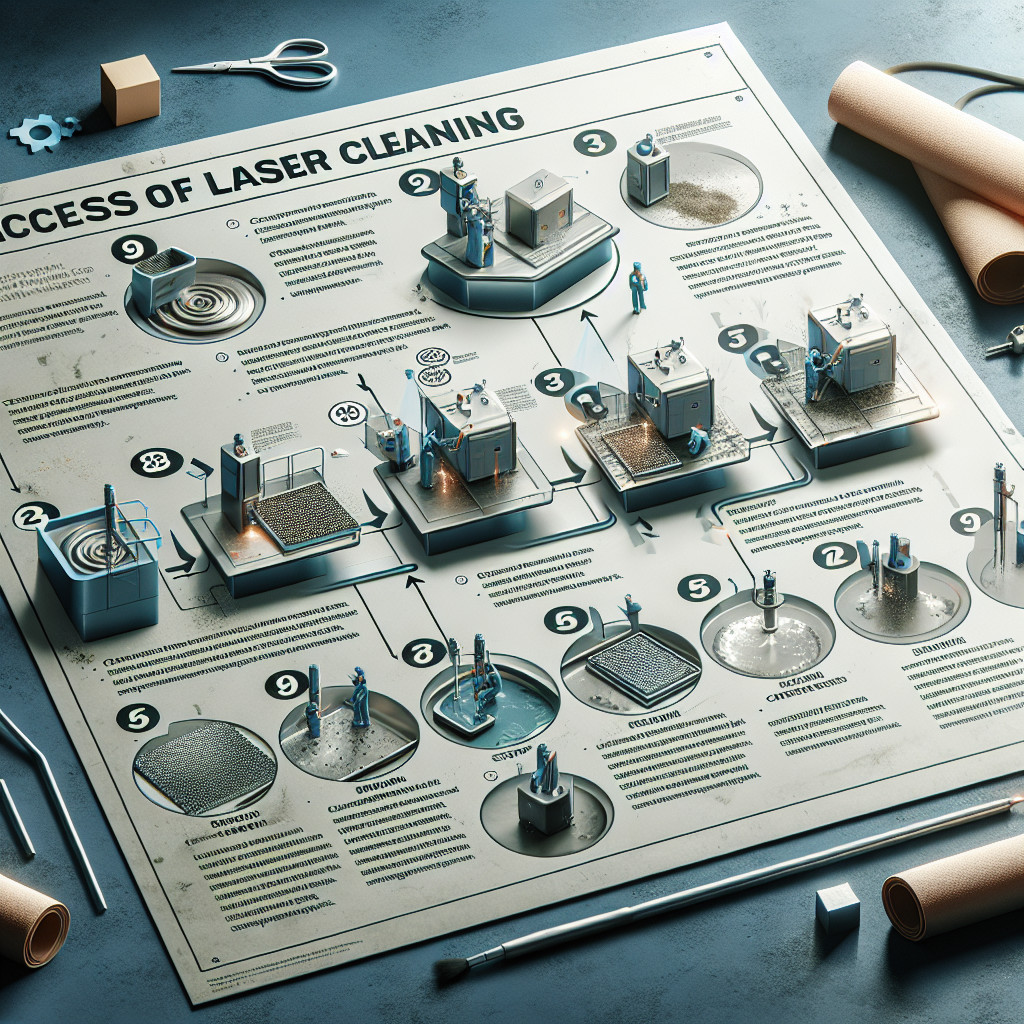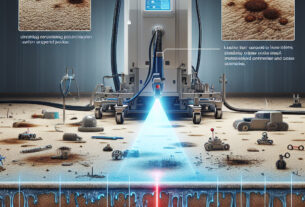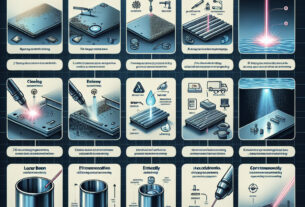- Benefits of Laser Cleaning for Tin Surfaces
- Comparison of Laser Cleaning vs. Traditional Cleaning Methods for Tin Surfaces
- How Laser Cleaning Works on Tin Surfaces
- Case Studies of Laser Cleaning for Tin Surface Contaminants
- Safety Considerations for Laser Cleaning Tin Surfaces
Benefits of Laser Cleaning for Tin Surfaces
| Benefit | Description |
|---|---|
| Non-contact cleaning | Laser cleaning does not require physical contact with the surface, reducing the risk of damage or scratching. |
| Precision cleaning | The focused laser beam can target specific areas for cleaning, ensuring thorough removal of contaminants. |
| No chemicals or abrasives | Laser cleaning does not use harsh chemicals or abrasive materials, making it environmentally friendly and safe for workers. |
| No residue | Unlike traditional cleaning methods, laser cleaning leaves behind no residue or waste material. |
| Fast and efficient | Laser cleaning is a quick and efficient process, reducing downtime and increasing productivity. |
| Cost-effective | While the initial investment in laser cleaning equipment may be higher, the long-term cost savings from reduced maintenance and cleaning expenses make it a cost-effective solution. |
Overall, laser cleaning offers a range of benefits for cleaning tin surfaces, making it an ideal choice for industries that require high-quality and efficient cleaning processes.
Comparison of Laser Cleaning vs. Traditional Cleaning Methods for Tin Surfaces
Laser Cleaning
Laser cleaning is a modern and efficient method of removing contaminants from tin surfaces. It involves using a high-powered laser beam to vaporize the impurities without damaging the underlying material. Laser cleaning is non-contact, which means there is no physical contact between the cleaning tool and the surface, reducing the risk of scratching or damaging the tin surface.
- Efficiency: Laser cleaning is highly efficient and can remove contaminants quickly and effectively.
- Precision: Laser cleaning allows for precise control over the cleaning process, ensuring that only the contaminants are removed without affecting the tin surface.
- Environmentally friendly: Laser cleaning does not require the use of chemicals or solvents, making it an environmentally friendly cleaning method.
- Cost-effective: While the initial cost of laser cleaning equipment may be high, the long-term cost savings from reduced maintenance and cleaning time can make it a cost-effective option.
Traditional Cleaning Methods
Traditional cleaning methods for tin surfaces include abrasive cleaning, chemical cleaning, and mechanical cleaning. These methods involve using abrasive materials, chemicals, or mechanical tools to remove contaminants from the surface.
- Abrasive cleaning: Abrasive cleaning involves using abrasive materials such as sandpaper or wire brushes to scrub away contaminants from the tin surface. While effective, abrasive cleaning can damage the surface and leave scratches.
- Chemical cleaning: Chemical cleaning involves using chemicals or solvents to dissolve and remove contaminants from the tin surface. While effective, chemical cleaning can be harmful to the environment and pose health risks to workers.
- Mechanical cleaning: Mechanical cleaning involves using mechanical tools such as brushes or scrubbers to remove contaminants from the tin surface. While effective, mechanical cleaning can be time-consuming and labor-intensive.
Comparison
When comparing laser cleaning to traditional cleaning methods for tin surfaces, several factors should be considered:
- Efficiency: Laser cleaning is more efficient than traditional cleaning methods, as it can remove contaminants quickly and effectively without damaging the tin surface.
- Precision: Laser cleaning offers precise control over the cleaning process, ensuring that only the contaminants are removed without affecting the tin surface.
- Environmental impact: Laser cleaning is environmentally friendly, as it does not require the use of chemicals or solvents that can harm the environment.
- Cost: While the initial cost of laser cleaning equipment may be high, the long-term cost savings from reduced maintenance and cleaning time can make it a cost-effective option compared to traditional cleaning methods.
In conclusion, laser cleaning is a superior cleaning method for tin surfaces compared to traditional cleaning methods. It offers efficiency, precision, environmental friendliness, and cost-effectiveness, making it the ideal choice for maintaining the quality of tin surfaces in various industries.
How Laser Cleaning Works on Tin Surfaces
How Does Laser Cleaning Work?
Laser cleaning works by focusing a laser beam onto the surface of the material to be cleaned. The intense heat generated by the laser vaporizes the contaminants and oxides, leaving behind a clean surface. The process is non-abrasive and does not require any chemicals or solvents, making it an environmentally friendly and cost-effective cleaning method.
The Benefits of Laser Cleaning on Tin Surfaces
- Efficiency: Laser cleaning is a fast and efficient method for removing contaminants from tin surfaces. It can be completed in a fraction of the time required by traditional cleaning methods.
- Precision: Laser cleaning allows for precise control over the cleaning process, ensuring that only the unwanted materials are removed without damaging the underlying metal.
- Safety: Laser cleaning is a safe method for removing contaminants from tin surfaces, as it does not produce any harmful fumes or residues.
- Environmentally Friendly: Laser cleaning does not require the use of chemicals or solvents, making it an environmentally friendly cleaning method.
- Cost-Effective: Laser cleaning is a cost-effective cleaning method, as it requires minimal maintenance and does not involve the use of expensive chemicals or solvents.
Conclusion
Laser cleaning is a highly effective method for removing contaminants and oxides from tin surfaces. This process offers a range of benefits, including efficiency, precision, safety, environmental friendliness, and cost-effectiveness. By using a high-powered laser beam to vaporize unwanted materials, laser cleaning provides a fast and efficient cleaning solution for tin surfaces.
Case Studies of Laser Cleaning for Tin Surface Contaminants
Case Study 1: Removal of Grease and Oil
One common type of contaminant found on tin surfaces is grease and oil. In a recent case study, a manufacturing facility that produces tin cans for food packaging was experiencing issues with grease and oil buildup on their production line. Traditional cleaning methods were ineffective and time-consuming, leading to production delays and increased costs.
The facility decided to try laser cleaning as a solution to their contamination problem. A laser cleaning system was installed on the production line, and the results were immediate. The laser was able to remove grease and oil from the tin surfaces quickly and efficiently, without causing any damage to the material. The facility saw a significant improvement in production efficiency and a reduction in cleaning costs.
Case Study 2: Removal of Rust and Corrosion
Another common issue with tin surfaces is rust and corrosion. In a case study conducted at a metal fabrication plant, tin surfaces were found to be heavily contaminated with rust and corrosion, leading to product defects and quality issues. Traditional cleaning methods were ineffective in removing the rust and corrosion, and the plant was facing significant losses due to rejected products.
The plant decided to implement laser cleaning as a solution to their contamination problem. The laser was able to remove the rust and corrosion from the tin surfaces with precision and accuracy, restoring the surfaces to their original condition. The plant saw a dramatic improvement in product quality and a reduction in rejected products, leading to increased profitability.
Case Study 3: Removal of Paint and Coatings
In a case study conducted at an automotive manufacturing plant, tin surfaces were found to be contaminated with paint and coatings. The plant was experiencing issues with paint adhesion and product quality due to the presence of these contaminants. Traditional cleaning methods were ineffective in removing the paint and coatings, leading to production delays and increased costs.
The plant decided to implement laser cleaning as a solution to their contamination problem. The laser was able to remove the paint and coatings from the tin surfaces with precision and efficiency, restoring the surfaces to their original condition. The plant saw a significant improvement in paint adhesion and product quality, leading to increased customer satisfaction and profitability.
Conclusion
These case studies demonstrate the effectiveness of laser cleaning for tin surface contaminants. Whether it is grease and oil, rust and corrosion, or paint and coatings, laser cleaning has proven to be a highly efficient and cost-effective solution for removing contaminants from tin surfaces. By implementing laser cleaning technology, businesses can improve production efficiency, reduce cleaning costs, and enhance product quality. Laser cleaning is truly a game-changer in the field of surface cleaning and contamination removal.
Safety Considerations for Laser Cleaning Tin Surfaces
Eye Protection
One of the most important safety considerations when using lasers for cleaning tin surfaces is eye protection. Laser beams can cause serious damage to the eyes if proper precautions are not taken. It is essential to wear appropriate laser safety goggles that are designed to block the specific wavelength of the laser being used.
Skin Protection
In addition to eye protection, it is also important to protect the skin from exposure to laser beams. Laser beams can cause burns and other skin damage if they come into direct contact with the skin. It is recommended to wear long sleeves and gloves when operating lasers for cleaning tin surfaces.
Ventilation
Another important safety consideration for laser cleaning tin surfaces is ventilation. Laser cleaning can produce fumes and particles that may be harmful if inhaled. It is important to ensure that the work area is well-ventilated to prevent the buildup of fumes and particles.
Training
Proper training is essential for anyone operating lasers for cleaning tin surfaces. It is important to understand how to safely operate the laser equipment and how to handle any potential hazards that may arise. Training should cover proper safety procedures, emergency protocols, and how to properly use personal protective equipment.
Equipment Maintenance
Regular maintenance of laser cleaning equipment is crucial for ensuring safety. It is important to regularly inspect and maintain the laser equipment to ensure that it is functioning properly and safely. Any damaged or malfunctioning equipment should be repaired or replaced immediately.
Conclusion
When using lasers for cleaning tin surfaces, it is important to prioritize safety. By following proper safety precautions, such as wearing eye protection, skin protection, ensuring proper ventilation, receiving training, and maintaining equipment, the risks associated with laser cleaning can be minimized. It is essential to prioritize safety to protect both the operator and the environment.
- Sure! Here are some questions related to Software for tracking employee hours: - 7 November 2025
- The role of AI in Employee monitoring software - 6 November 2025
- Sure! Here are some questions related to The role of computer monitoring software in education, using variations of the term computer monitoring software: - 3 October 2025



